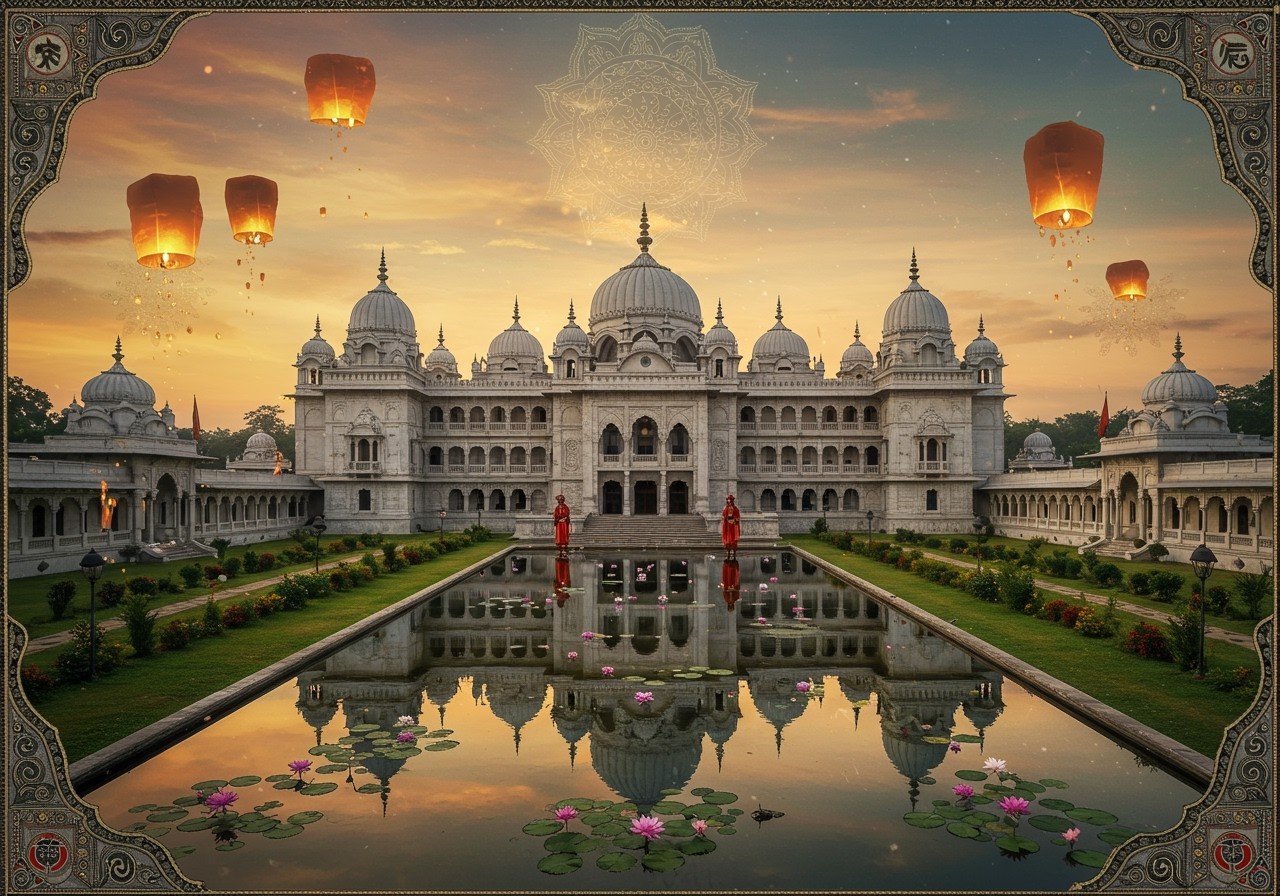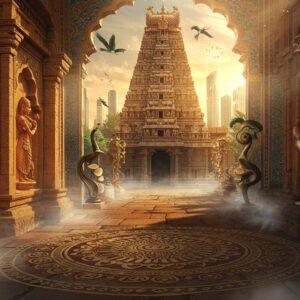
Embark on a spiritual journey through Tripura’s regal heritage, where centuries of history and vibrant culture intertwine. Discover the legacy of the Manikya dynasty, their influence on the region, and the significant role of Hinduism in shaping Tripura’s traditions. This guide is crafted for those who cherish tradition and seek the convenience of online shopping for authentic ritual items.
A Glimpse into Tripura’s History
Tripura’s history is steeped in captivating legends and narratives. The Manikya dynasty, established the Tripura Kingdom in the 15th century. Through strategic alliances and occasional conflicts, the kingdom flourished and expanded. Eventually, Tripura became a part of British India and later transitioned into independent India. The socio-political landscape played a crucial role in shaping its royal lineage and the way the kingdom was governed.
Tripura’s Architectural Marvels: Palaces of a Princely State
Tripura’s palaces stand as magnificent testaments to its royal past. Each palace whispers tales of bygone eras, showcasing the enduring legacy of the Manikya dynasty. Let’s embark on a virtual tour of these majestic structures.
Ujjayanta Palace: A Symbol of Victory
In the heart of Agartala stands the resplendent Ujjayanta Palace. Originally constructed in 1862 by King Ishan Chandra Manikya, it was tragically destroyed by an earthquake in 1897. With unwavering resolve, Maharaja Radha Kishore Manikya rebuilt it between 1899 and 1901. This grand palace served as the royal residence until Tripura’s merger with the Indian Union in 1947. In 1972, it was transformed into a museum.
Ujjayanta Palace showcases a breathtaking blend of architectural styles—neoclassical, Mughal, and Roman—evident in its majestic domes (reaching a height of 86 feet), ornate arched doorways, and intricate carvings. Now a museum, it houses a rich collection of artifacts, sculptures, and paintings, offering a glimpse into Tripura’s vibrant cultural tapestry. The name “Ujjayanta” aptly translates to “The Palace of Victory,” a fitting tribute to its resilience and grandeur.
Neermahal: The Jewel of Rudrasagar Lake
Neermahal, or “Water Palace,” graces the middle of Rudrasagar Lake. Commissioned by Maharaja Bir Bikram Kishore Manikya Bahadur, its construction spanned from 1930 to 1938. It served as a tranquil summer residence for the royal family. Located approximately 53 km from Agartala, Neermahal showcases a harmonious fusion of Hindu and Muslim architectural elements.
This architectural marvel is divided into two distinct sections: the Andar Mahal, the private quarters for the royal family, and an open-air theatre designed for cultural performances. With 24 rooms and elegant stairways leading to the lake, Neermahal holds the distinction of being India’s largest lake palace and the only one in Eastern India.
Kunjaban Palace: A Haven of Tranquility
Built in 1917 by Maharaja Birendra Kishore Manikya, Kunjaban Palace was envisioned as a peaceful suburban retreat. This serene haven welcomed the celebrated poet Rabindranath Tagore during his final visit in 1926. Today, it serves as the official residence of the Governor of Tripura.
Tripura Castle Hotel: A Royal Retreat in Shillong
While located in Shillong, Tripura Castle Hotel offers another fascinating glimpse into Tripura’s royal legacy. Maharaja Bir Bikram Manikya built this charming retreat in the 1920s. It has since been transformed into a luxurious hotel, allowing guests to experience a touch of royal living.
Preserving Tripura’s Royal Heritage
Dedicated efforts are underway to preserve these historical treasures. The state government and cultural organizations are actively involved in restoration projects, ensuring these architectural gems remain vibrant symbols of Tripura’s rich heritage. Tourism contributes to heritage conservation while facing challenges in balancing development with preservation.
Community initiatives play a vital role in educating younger generations about Tripura’s rich history, fostering a sense of pride and responsibility. Digital documentation and advanced technologies are employed to safeguard these stories for generations to come.
Get Traditional Puja Items for Your Tripura Temple Visit
Planning a visit to Tripura’s magnificent temples and historical sites? Poojn.in, India’s largest Dashakarma bhandar, offers a wide selection of authentic puja items tailored to Tripura’s rich cultural traditions. We provide everything you need to enhance your spiritual experience.
Our offerings include:
- Pure cotton dhotis, essential for temple entry, available here.
- Traditional brass and copper items for offerings, browse our collection.
- Authentic kumkum and chandan for religious ceremonies, find them here.
- Complete puja thalis and accessories, explore our range.
We offer pan-India delivery, ensuring convenient access to these essential items. All products are quality-assured and carefully packaged.
To order your puja items for your Tripura heritage tour:
- Visit: www.poojn.in
- Call: 03369029784
- WhatsApp: 9476142738
Our knowledgeable team is available to assist you in selecting the appropriate items based on specific temple customs and requirements. We strive to ensure you have the right ritual materials for a respectful and enriching experience at Tripura’s royal temples and sacred sites.
Tripura’s Palaces: A Living Legacy
Tripura’s palaces are not mere historical relics; they are living embodiments of a glorious past. They offer a profound connection to the stories of kings and kingdoms that shaped this region. As you traverse the halls of Ujjayanta Palace, journey to the enchanting Neermahal, and wander through the serene Kunjaban Palace, you’ll feel a deep connection to a royal legacy that continues to inspire and resonate.
Preserving these architectural marvels is not just about maintaining structures; it’s about cherishing a culture and history that continues to shape lives today. The collective commitment of the government, local communities, and individuals ensures that these palaces remain vibrant symbols of Tripura’s rich heritage.
FAQs: Exploring Tripura’s Royal Heritage
What are the must-visit palaces in Tripura? Tripura boasts several magnificent palaces, each with its own unique charm. Ujjayanta Palace, the former royal residence turned museum, is a must-see. Neermahal, the stunning lake palace, offers a unique architectural experience. And don’t miss Kunjaban Palace, a tranquil retreat with historical significance.
Who were some of the prominent rulers of Tripura? The Manikya dynasty reigned over Tripura for centuries. Notable rulers include Maharaja Bir Bikram Kishore Manikya, known for his architectural contributions like Neermahal, and Maharaja Radha Kishore Manikya, who rebuilt Ujjayanta Palace. Their reigns spanned several centuries.
What makes Ujjayanta Palace historically significant? Ujjayanta Palace served as the royal residence of the Manikya kings until Tripura merged with India in 1947. Originally built in 1862, it was rebuilt after an earthquake in 1897. Today, it stands as a museum showcasing Tripura’s rich history and culture, reflecting the grandeur of its royal past.
How has Hinduism shaped Tripura’s culture? Hinduism has profoundly influenced Tripura’s culture. This influence is visible in the state’s vibrant festivals, numerous temples, and traditional rituals. Festivals like Durga Puja and Diwali are celebrated with great enthusiasm, reflecting the deep-rooted Hindu faith of the people.
What is Neermahal famous for? Neermahal, also known as the “Water Palace,” is renowned for its unique blend of Hindu and Mughal architecture. Situated on Rudrasagar Lake, it is a picturesque landmark and a popular tourist destination. As the largest lake palace in India, its architectural splendor and serene location make it truly remarkable.
How can I delve deeper into Tripura’s royal history? To truly immerse yourself in Tripura’s regal past, visit its palaces, museums, and historical sites. Guided tours can enhance your experience. They provide valuable insights into the lives of the royals, the significance of various landmarks, and the rich history they represent.
What role did the Manikya dynasty play in shaping Tripura? The Manikya dynasty played a pivotal role in shaping Tripura’s history, culture, and traditions. They ruled for centuries. They contributed significantly to the region’s cultural heritage and development.


